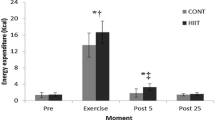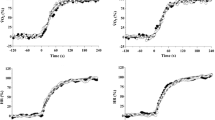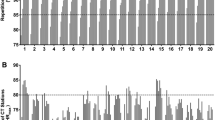Abstract
This study compared the physiological responses to heavy continuous (HC), short-intermittent (SI), and long-intermittent (LI) treadmill exercise protocols in non-endurance adolescent males. Nine adolescents (14 ± 0.6 years) performed a maximal incremental treadmill test followed, on separate days, by a SI [30 s at 110% of maximal aerobic velocity (MAV) with 30 s recovery at 50%], a LI (3 min at 95% of MAV with 3 min recovery at 35%), and a HC (at 83% of MAV) aerobic exercise protocol. VO2 and HR were measured continuously, and blood samples were obtained prior to and after the protocols. The duration of exercise and the distance covered were longer (p < 0.05) in HC and LI versus SI. All participants reached 80 and 85% of VO2peak irrespective of the protocol, while more participants reached 90 and 95% of VO2peak in the intermittent protocols (9 and 6, respectively) versus HC (5 and 3, respectively). The time spent above 80 and 85% of VO2peak was higher in HC and LI versus SI; the time above 90% was higher only in LI versus SI, and the time above 95% was higher in LI versus HC and SI. The total VO2 consumed was greater in HC and LI versus SI. Lactate was higher after LI versus HC. In conclusion, when matched for exhaustion level, LI is more effective in stimulating the aerobic system compared to both HC and SI, while HC aerobic exercise appears equally effective to SI. Nevertheless, adolescents have to exercise for a longer time in HC and LI to achieve these effects.



Similar content being viewed by others
References
Astrand I, Astrand PO, Christensen EH, Hedman R (1960) Intermittent muscular work. Acta Physiol Scand 48:448–453
Baquet G, Berthoin S, Dupont G, Blondel N, Fabre C, van Praagh E (2002a) Effects of high intensity intermittent training on peak VO(2) in prepubertal children. Int J Sports Med 23:439–444
Baquet G, Berthoin S, Van Praagh E (2002b) Are intensified physical education sessions able to elicit heart rate at a sufficient level to promote aerobic fitness in adolescents? Res Q Exerc Sport 73:282–288
Baquet G, van Praagh E, Berthoin S (2003) Endurance training and aerobic fitness in young people. Sports Med 33:1127–1143
Belcastro AN, Bonen A (1975) Lactic acid removal rates during controlled and uncontrolled recovery exercise. J Appl Physiol 39:932–936
Berthoin S, Baquet G, Dupont G, Blondel N, Mucci P (2003) Critical velocity and anaerobic distance capacity in prepubertal children. Can J Appl Physiol 28:561–575
Berthoin S, Baquet G, Dupont G, Van Praagh E (2006) Critical velocity during continuous and intermittent exercises in children. Eur J Appl Physiol 98:132–138
Billat LV (2001) Interval training for performance: a scientific and empirical practice. Special recommendations for middle- and long-distance running. Part I: aerobic interval training. Sports Med 31:13–31
Billat VL, Hill DW, Pinoteau J, Petit B, Koralsztein JP (1996) Effect of protocol on determination of velocity at VO2 max and on its time to exhaustion. Arch Physiol Biochem 104:313–321
Billat V, Binsse V, Petit B, Koralsztein JP (1998) High level runners are able to maintain a VO2 steady-state below VO2max in an all-out run over their critical velocity. Arch Physiol Biochem 106:38–45
Billat VL, Blondel N, Berthoin S (1999a) Determination of the velocity associated with the longest time to exhaustion at maximal oxygen uptake. Eur J Appl Physiol Occup Physiol 80:159–161
Billat VL, Flechet B, Petit B, Muriaux G, Koralsztein JP (1999b) Interval training at VO2max: effects on aerobic performance and overtraining markers. Med Sci Sports Exerc 31:156–163
Billat VL, Slawinski J, Bocquet V, Demarle A, Lafitte L, Chassaing P, Koralsztein JP (2000) Intermittent runs at the velocity associated with maximal oxygen uptake enables subjects to remain at maximal oxygen uptake for a longer time than intense but submaximal runs. Eur J Appl Physiol 81:188–196
Boileau RA, Misner JE, Dykstra GL, Spitzer TA (1983) Blood lactic acid removal during treadmill and bicycle exercise at various intensities. J Sports Med Phys Fitness 23:159–167
Boudet G, Albuisson E, Bedu M, Chamoux A (2004) Heart rate running speed relationships-during exhaustive bouts in the laboratory. Can J Appl Physiol 29:731–742
Christmass MA, Dawson B, Arthur PG (1999a) Effect of work and recovery duration on skeletal muscle oxygenation and fuel use during sustained intermittent exercise. Eur J Appl Physiol Occup Physiol 80:436–447
Christmass MA, Dawson B, Passeretto P, Arthur PG (1999b) A comparison of skeletal muscle oxygenation and fuel use in sustained continuous and intermittent exercise. Eur J Appl Physiol Occup Physiol 80:423–435
Cohen J (1988) Statistical power analysis for the behavioral sciences. Erlbaum, Hillsdale
Cunningham DA, Paterson DH (1985) Age specific prediction of maximal oxygen uptake in boys. Can J Appl Sport Sci 10:75–80
Daniels J, Scardina N (1984) Interval training and performance. Sports Med 1:327–334
Demarie S, Koralsztein JP, Billat V (2000) Time limit and time at VO2max during a continuous and an intermittent run. J Sports Med Phys Fitness 40:96–102
Dorado C, Sanchis-Moysi J, Calbet JA (2004) Effects of recovery mode on performance, O2 uptake, and O2 deficit during high-intensity intermittent exercise. Can J Appl Physiol 29:227–244
Dupont G, Berthoin S (2004) Time spent at a high percentage of VO2max for short intermittent runs: active versus passive recovery. Can J Appl Physiol 29(Suppl):S3–S16
Dupont G, Blondel N, Lensel G, Berthoin S (2002) Critical velocity and time spent at a high level of VO2 for short intermittent runs at supramaximal velocities. Can J Appl Physiol 27:103–115
Dupont G, Blondel N, Berthoin S (2003a) Time spent at VO2max: a methodological issue. Int J Sports Med 24:291–297
Dupont G, Blondel N, Berthoin S (2003b) Performance for short intermittent runs: active recovery vs. passive recovery. Eur J Appl Physiol 89:548–554
Dupont G, Moalla W, Guinhouya C, Ahmaidi S, Berthoin S (2004) Passive versus active recovery during high-intensity intermittent exercises. Med Sci Sports Exerc 36:302–308
Esfarjani F, Laursen PB (2007) Manipulating high-intensity interval training: effects on VO2max, the lactate threshold and 3000 m running performance in moderately trained males. J Sci Med Sport 10:27–35
Esteve-Lanao J, Lucia A, de Koning JJ, Foster C (2008) How do humans control physiological strain during strenuous endurance exercise? PLoS One 3:e2943
Fox EL, Bartels RL, Billings CE, Mathews DK, Bason R, Webb WM (1973) Intensity and distance of interval training programs and changes in aerobic power. Med Sci Sports 5:18–22
Franch J, Madsen K, Djurhuus MS, Pedersen PK (1998) Improved running economy following intensified training correlates with reduced ventilatory demands. Med Sci Sports Exerc 30:1250–1256
Gaesser GA, Poole DC (1996) The slow component of oxygen uptake kinetics in humans. Exerc Sport Sci Rev 24:35–71
Gaiga MC, Docherty D (1995) The effect of an aerobic interval training program on intermittent anaerobic performance. Can J Appl Physiol 20:452–464
Gamelin FX, Baquet G, Berthoin S, Thevenet D, Nourry C, Nottin S, Bosquet L (2009) Effect of high intensity intermittent training on heart rate variability in prepubescent children. Eur J Appl Physiol 105:731–738
Hill DW, Rowell AL (1997) Responses to exercise at the velocity associated with VO2max. Med Sci Sports Exerc 29:113–116
Krustrup P, Söderlund K, Mohr M, Bangsbo J (2004) The slow component of oxygen uptake during intense, sub-maximal exercise in man is associated with additional fibre recruitment. Pflugers Arch 447:855–866
Lai N, Nasca MM, Silva MA, Silva FT, Whipp BJ, Cabrera ME (2008) Influence of exercise intensity on pulmonary oxygen uptake kinetics at the onset of exercise and recovery in male adolescents. Appl Physiol Nutr Metab 33:107–117
MacDougall D, Sale D (1981) Continuous vs. interval training: a review for the athlete and the coach. Can J Appl Sport Sci 6:93–97
Matsuzaka A, Takahashi Y, Yamazoe M, Kumakura N, Ikeda A, Wilk B, Bar-Or O (2004) Validity of the multistage 20-m shuttle-run test for Japanese children, adolescents, and adults. Ped Exer Sci 4:312–318
Midgley AW, Mc Naughton LR (2006) Time at or near VO2max during continuous and intermittent running. A review with special reference to considerations for the optimisation of training protocols to elicit the longest time at or near VO2max. J Sports Med Phys Fitness 46:1–14
Midgley AW, McNaughton LR, Wilkinson M (2006) Is there an optimal training intensity for enhancing the maximal oxygen uptake of distance runners? Empirical research findings, current opinions, physiological rationale and practical recommendations. Sports Med 36:117–132
Millet GP, Candau R, Fattori P, Bignet F, Varray A (2003a) VO2 responses to different intermittent runs at velocity associated with VO2max. Can J Appl Physiol 28:410–423
Millet GP, Libicz S, Borrani F, Fattori P, Bignet F, Candau R (2003b) Effects of increased intensity of intermittent training in runners with differing VO2 kinetics. Eur J Appl Physiol 90:50–57
O’Brien BJ, Wibskov J, Knez WL, Paton CD, Harvey JT (2008) The effects of interval-exercise duration and intensity on oxygen consumption during treadmill running. J Sci Med Sport 11:287–290
Poole DC, Ward SA, Gardner GW, Whipp BJ (1988) Metabolic and respiratory profile of the upper limit for prolonged exercise in man. Ergonomics 31:1265–1279
Rowland TW (1996) Exercise testing. In: Developmental exercise physiology. Human Kinetics, Champaign, pp 36–37
Rozenek R, Funato K, Kubo J, Hoshikawa M, Matsuo A (2007) Physiological responses to interval training sessions at velocities associated with VO2max. J Strength Cond Res 21:188–192
Smith TP, McNaughton LR, Marshall KJ (1999) Effects of 4-wk training using Vmax/Tmax on VO2max and performance in athletes. Med Sci Sports Exerc 31:892–896
Tardieu-Berger M, Thevenet D, Zouhal H, Prioux J (2004) Effects of active recovery between series on performance during an intermittent exercise model in young endurance athletes. Eur J Appl Physiol 93:145–152
Thevenet D, Tardieu M, Zouhal H, Jacob C, Abderrahman BA, Prioux J (2007a) Influence of exercise intensity on time spent at high percentage of maximal oxygen uptake during an intermittent session in young endurance-trained athletes. Eur J Appl Physiol 102:19–26
Thevenet D, Tardieu-Berger M, Berthoin S, Prioux J (2007b) Influence of recovery mode (passive vs. active) on time spent at maximal oxygen uptake during an intermittent session in young and endurance-trained athletes. Eur J Appl Physiol 99:133–142
Thevenet D, Leclair E, Tardieu-Berger M, Berthoin S, Regueme S, Prioux J (2008) Influence of recovery intensity on time spent at maximal oxygen uptake during an intermittent session in young, endurance-trained athletes. J Sports Sci 26:1313–1321
Wakefield BR, Glaister M (2009) Influence of work-interval intensity and duration on time spent at a high percentage of VO2max during intermittent supramaximal exercise. J Strength Cond Res 23:2548–2554
Wenger HA, Bell GJ (1986) The interactions of intensity, frequency and duration of exercise training in altering cardiorespiratory fitness. Sports Med 3:346–356
Whipp BJ (1994) The slow component of O2 uptake kinetics during heavy exercise. Med Sci Sports Exerc 26:1319–1326
Acknowledgments
The experiments comply with the current laws of the country in which they were performed.
Conflict of interest statement
The authors declare that they have no conflict of interest.
Author information
Authors and Affiliations
Corresponding author
Additional information
Communicated by Klaas Westerterp.
Rights and permissions
About this article
Cite this article
Zafeiridis, A., Sarivasiliou, H., Dipla, K. et al. The effects of heavy continuous versus long and short intermittent aerobic exercise protocols on oxygen consumption, heart rate, and lactate responses in adolescents. Eur J Appl Physiol 110, 17–26 (2010). https://doi.org/10.1007/s00421-010-1467-x
Accepted:
Published:
Issue Date:
DOI: https://doi.org/10.1007/s00421-010-1467-x




